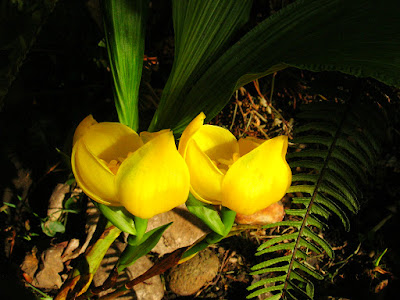Anguloa clowesii is native to Colombia and Venezuela. It grows there in the mountains at elevations of 1800 to 2500 meters, in conditions that provide roots a lot of moisture...
Anguloa clowesii also called as Cradle Orchid, Tulip Orchid, Clowes Anguloa, Anguloa clowesii var. aurea, Anguloa clowesii var. flava, is a species of the genus Anguloa. This species was described by John Lindley in 1844.
IDENTIFY ANGULOA CLOWESII
Anguloa clowesii is native to Colombia and Venezuela. It grows there in the mountains at elevations of 1800 to 2500 meters, in conditions that provide roots a lot of moisture. In these regions there is a dry season, which corresponds to the period of leaf shedding.
Cradle Orchid is a cool to cold growing, large terrestrial sometimes epiphytic plant, with leaves growing up to 60 cm in length, with large, clustered, conical-pyriform, sulcate, slightly compressed pseudobulbs with 3 to 4, deciduous, apical, plicate, obovate or elliptical, obtuse leaves.
Tulip Orchid has large, waxy, highly fragrant, solitary flowers smelling of wintergreen and chocolate occurring from the spring through the summer on an erect, 30 cm long, sheathed, often 2 inflorescence holding the flowers at mid-leaf height that arise basally as the new growths appear in the late winter. The flowers are very large, 8 cm in diameter, yellow, tulip-shaped flowers. The flowers are very durable and last up to several months.
ANGULOA CLOWESII CARE AND CULTURE
Cultural information should only be used as a guide, and should be to be adapted to suit you. Your physical location; where you grow your plants, how much time you have to devote to their care, and many other factors, will need to be taken into account. Only then can you decide on the cultural methods that best suit you and your plants.
Light:
In nature, Anguloa clowesii are located on the slopes of hills covered with dwarf vegetation. Growing on the slopes of the hills are exposed to the action of the full sun, but not all day. In South America, they often grow on the southern slopes, without the vegetation covering the sun, and during the day are exposed to very bright, scattered light.
Temperature:
It is a plant with moderate thermal requirements. These plants require temperatures from cold to moderate, but they tolerate warm summer days well. The most appropriate day temperature is 21-27 ° C , while at night it is around 10 to 15 ° C. They can also grow and bloom under moderate climates.
Humidity:
During the summer months a very high humidity (70%) is recommended, especially since they have large, wrinkled leaves, through which they lose moisture quite quickly. In winter they tolerate lower humidity, especially when the leaves are already falling.
Substrate, growing media and repotting:
Anguloa clowesii needs a standard substrate for orchids.
Watering:
This plant requires clean water, rainwater, distilled water or reverse osmosis filters. It likes large amounts of water, especially during active growth. It should never dry up. It may be possible to reach a slight drying of the substrate, but never allow the roots to dry completely.
In the winter months, from the end of November to mid-January, the root system should be relatively dry for about 6-8 weeks. The plant is then watered every few weeks, observing pseudobulbs, to prevent them from getting too wrinkled. After noticing new increments, the frequency of watering increases at the base of the old pseudobulb. When new increments reach the size of 10-12 cm, the fertilizer doses are also increased.
Fertilizer:
As a fertilizer, you should use 20-10-20 fertilizer for orchids, that is with high nitrogen levels. These plants require a large amount of fertilizer, and even tolerate slow-release fertilizers applied on the surface of the substrate. However, be careful not to overdose, because it may cause blackening of the tips of the leaves. Higher doses of fertilizers are required in the spring and summer, in autumn they should be slightly reduced and the fertilization should be completely stopped for 6-8 weeks of winter, coinciding with the period of drought. At that time, only clean water is used for watering.
Rest period:
When Anguloa clowesii loses leaves in the autumn, it is necessary to limit watering and stop fertilization for 6-8 weeks.














COMMENTS